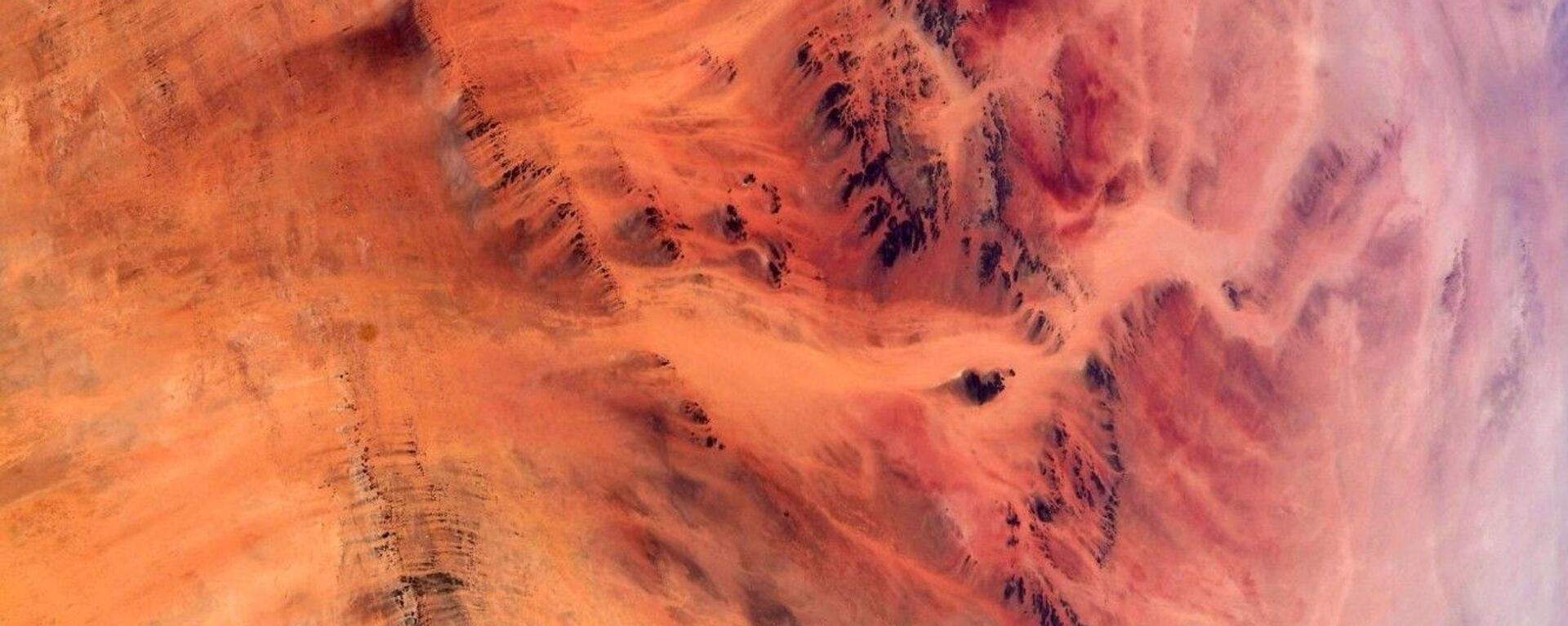https://sputnikglobe.com/20220226/from-alien-sex-toy-to-tadpole-tweeps-puzzled-by-bowling-pin-shape-on-mars-caught-by-nasa-rover-1093390036.html
From 'Alien Sex Toy' to 'Tadpole': Tweeps Puzzled By Bowling Pin Shape on Mars Caught by NASA Rover
From 'Alien Sex Toy' to 'Tadpole': Tweeps Puzzled By Bowling Pin Shape on Mars Caught by NASA Rover
Sputnik International
NASA's Curiosity rover was launched on 26 November 2011 and landed the following year to explore the Gale crater on the Red Planet as part of the agency's Mars... 26.02.2022, Sputnik International
2022-02-26T10:56+0000
2022-02-26T10:56+0000
2022-11-30T10:10+0000
curiosity rover
perseverance
nasa
mars
https://cdn1.img.sputnikglobe.com/img/106848/97/1068489703_0:509:5000:3322_1920x0_80_0_0_189ca7c3137d1b4cb7d35012356ededd.jpg
NASA's Curiosity Rover has dished up yet another remarkable image from the surface of the planet Mars, with space fans on social media letting their imaginations run free as they poured over the footage. The odd object caught on Mastcam, onboard NASA's Mars rover, on 13 February 2022 outwardly appears to resemble a bowling pin shape. Many wondered what the shape might be, as NASA refrained from confirming what it really was. Some of the more exotic suggestions ranged from Martian bowling pin to an alien's shoe horn, or even the discarded side-mirror from a Tesla car. Others on social media went with more plausible options, such as erosion. The Curiosity Rover’s Mast Camera takes colour images, three-dimensional stereo images, and colour video footage of the martian terrain with a powerful zoom lens. Overall, the rover has seventeen cameras, some in rover navigation, while others are designated for science investigations with their application-specific sets of optics. Curiosity landed in the 96-mile-wide (154 kilometres) Gale Crater on Mars in August 2012 and has been on a mission to determine if Mars was ever able to support living organisms. The NASA/JPL Mars Science Laboratory/Curiosity Project Team was able to determine that Gale's floor was a potentially habitable environment billions of years ago, likely sustaining a lake-and-stream system for millions of years. The rover has been collecting powdered rock samples with its percussive drill and as of 22 February 2022 was active on Mars for 3394 sols (3487 total days; 9 years, 200 days). Scientists are waiting for further fascinating data from another Mars rover — Perseverance - a NASA robot that landed on 18 February 2021 in Jezero Crater. Perseverance is hunting for signs of ancient Mars life while collecting dozens of samples scheduled to be returned to Earth for analysis likely as early as 2031.
https://sputnikglobe.com/20220226/ufo-pundit-claims-nasa-hiding-facts-after-discovering-various-alien-objects-on-mars-1093383430.html
mars
Sputnik International
feedback@sputniknews.com
+74956456601
MIA „Rossiya Segodnya“
2022
News
en_EN
Sputnik International
feedback@sputniknews.com
+74956456601
MIA „Rossiya Segodnya“
Sputnik International
feedback@sputniknews.com
+74956456601
MIA „Rossiya Segodnya“
curiosity rover, perseverance , nasa, mars
curiosity rover, perseverance , nasa, mars
From 'Alien Sex Toy' to 'Tadpole': Tweeps Puzzled By Bowling Pin Shape on Mars Caught by NASA Rover
10:56 GMT 26.02.2022 (Updated: 10:10 GMT 30.11.2022) NASA's Curiosity rover was launched on 26 November 2011 and landed the following year to explore the Gale crater on the Red Planet as part of the agency's Mars Science Laboratory (MSL) mission, since then sending data and stunning raw images of the barren giant.
NASA's Curiosity Rover has dished up yet another remarkable image from the surface of the planet
Mars, with space fans on social media letting their imaginations run free as they poured over the footage.
The odd object caught on Mastcam, onboard NASA's Mars rover, on 13 February 2022 outwardly appears to resemble a bowling pin shape. Many wondered what the shape might be, as NASA refrained from confirming what it really was.
Some of the more exotic suggestions ranged from Martian bowling pin to an alien's shoe horn, or even the discarded side-mirror from a Tesla car.
Others on social media went with more plausible options, such as erosion.
The Curiosity Rover’s Mast Camera
takes colour images, three-dimensional stereo images, and colour video footage of the martian terrain with a powerful zoom lens.

26 February 2022, 02:49 GMT
Overall, the rover has seventeen cameras, some in rover navigation, while others are designated for science investigations with their application-specific sets of optics. Curiosity landed in the 96-mile-wide (154 kilometres) Gale Crater on Mars in August 2012 and has been on a mission to determine if Mars was ever able to support living organisms.
The NASA/JPL Mars Science Laboratory/Curiosity Project Team was able to determine that Gale's floor was a potentially habitable environment billions of years ago, likely sustaining a lake-and-stream system for millions of years. The rover has been collecting powdered rock samples with its percussive drill and as of 22 February 2022 was active on Mars for 3394 sols (3487 total days; 9 years, 200 days).
Scientists are waiting for further fascinating data from another Mars rover — Perseverance - a NASA robot that landed on 18 February 2021 in Jezero Crater.
Perseverance is hunting for signs of ancient Mars life while collecting dozens of samples scheduled to be returned to Earth for analysis likely as early as 2031.



